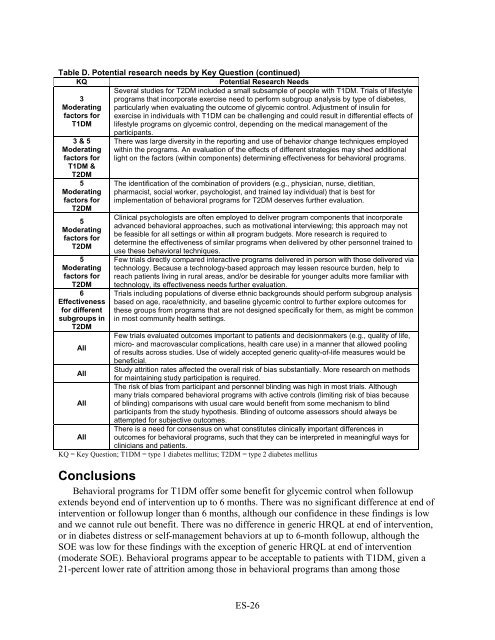Behavioral Programs for Diabetes Mellitus
diabetes-behavior-programs-report-150924
diabetes-behavior-programs-report-150924
- No tags were found...
You also want an ePaper? Increase the reach of your titles
YUMPU automatically turns print PDFs into web optimized ePapers that Google loves.
Table D. Potential research needs by Key Question (continued)<br />
KQ<br />
Potential Research Needs<br />
3<br />
Moderating<br />
factors <strong>for</strong><br />
T1DM<br />
3 & 5<br />
Moderating<br />
factors <strong>for</strong><br />
T1DM &<br />
T2DM<br />
5<br />
Moderating<br />
factors <strong>for</strong><br />
T2DM<br />
5<br />
Moderating<br />
factors <strong>for</strong><br />
T2DM<br />
5<br />
Moderating<br />
factors <strong>for</strong><br />
T2DM<br />
6<br />
Effectiveness<br />
<strong>for</strong> different<br />
subgroups in<br />
T2DM<br />
All<br />
All<br />
All<br />
All<br />
Several studies <strong>for</strong> T2DM included a small subsample of people with T1DM. Trials of lifestyle<br />
programs that incorporate exercise need to per<strong>for</strong>m subgroup analysis by type of diabetes,<br />
particularly when evaluating the outcome of glycemic control. Adjustment of insulin <strong>for</strong><br />
exercise in individuals with T1DM can be challenging and could result in differential effects of<br />
lifestyle programs on glycemic control, depending on the medical management of the<br />
participants.<br />
There was large diversity in the reporting and use of behavior change techniques employed<br />
within the programs. An evaluation of the effects of different strategies may shed additional<br />
light on the factors (within components) determining effectiveness <strong>for</strong> behavioral programs.<br />
The identification of the combination of providers (e.g., physician, nurse, dietitian,<br />
pharmacist, social worker, psychologist, and trained lay individual) that is best <strong>for</strong><br />
implementation of behavioral programs <strong>for</strong> T2DM deserves further evaluation.<br />
Clinical psychologists are often employed to deliver program components that incorporate<br />
advanced behavioral approaches, such as motivational interviewing; this approach may not<br />
be feasible <strong>for</strong> all settings or within all program budgets. More research is required to<br />
determine the effectiveness of similar programs when delivered by other personnel trained to<br />
use these behavioral techniques.<br />
Few trials directly compared interactive programs delivered in person with those delivered via<br />
technology. Because a technology-based approach may lessen resource burden, help to<br />
reach patients living in rural areas, and/or be desirable <strong>for</strong> younger adults more familiar with<br />
technology, its effectiveness needs further evaluation.<br />
Trials including populations of diverse ethnic backgrounds should per<strong>for</strong>m subgroup analysis<br />
based on age, race/ethnicity, and baseline glycemic control to further explore outcomes <strong>for</strong><br />
these groups from programs that are not designed specifically <strong>for</strong> them, as might be common<br />
in most community health settings.<br />
Few trials evaluated outcomes important to patients and decisionmakers (e.g., quality of life,<br />
micro- and macrovascular complications, health care use) in a manner that allowed pooling<br />
of results across studies. Use of widely accepted generic quality-of-life measures would be<br />
beneficial.<br />
Study attrition rates affected the overall risk of bias substantially. More research on methods<br />
<strong>for</strong> maintaining study participation is required.<br />
The risk of bias from participant and personnel blinding was high in most trials. Although<br />
many trials compared behavioral programs with active controls (limiting risk of bias because<br />
of blinding) comparisons with usual care would benefit from some mechanism to blind<br />
participants from the study hypothesis. Blinding of outcome assessors should always be<br />
attempted <strong>for</strong> subjective outcomes.<br />
There is a need <strong>for</strong> consensus on what constitutes clinically important differences in<br />
outcomes <strong>for</strong> behavioral programs, such that they can be interpreted in meaningful ways <strong>for</strong><br />
clinicians and patients.<br />
KQ = Key Question; T1DM = type 1 diabetes mellitus; T2DM = type 2 diabetes mellitus<br />
Conclusions<br />
<strong>Behavioral</strong> programs <strong>for</strong> T1DM offer some benefit <strong>for</strong> glycemic control when followup<br />
extends beyond end of intervention up to 6 months. There was no significant difference at end of<br />
intervention or followup longer than 6 months, although our confidence in these findings is low<br />
and we cannot rule out benefit. There was no difference in generic HRQL at end of intervention,<br />
or in diabetes distress or self-management behaviors at up to 6-month followup, although the<br />
SOE was low <strong>for</strong> these findings with the exception of generic HRQL at end of intervention<br />
(moderate SOE). <strong>Behavioral</strong> programs appear to be acceptable to patients with T1DM, given a<br />
21-percent lower rate of attrition among those in behavioral programs than among those<br />
ES-26


